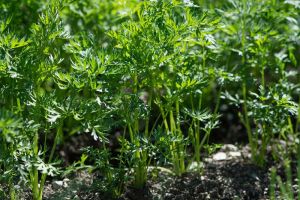Carrot

Carrots are difficult to grow because they require
15 days or even 3 weeks for germination. This
long germination period makes the carrot very
sensitive to weediness.
Examples of technical itineraries
Soil preparation
Growing on a tarpaulin is a good precedent for carrots as it cleans the soil of weeds.
The seedbed is prepared by spreading between 3 and 10 cm of compost or fine shredding to prevent weed infestation and and promote soil-seed contact. Chaff can be used instead of compost or shredded material, in which case the seed should be sown and then then cover with chaff. Chaff has the ability to retain moisture which means you can reduce watering, especially if there is especially if there is compost underneath.
To reduce weed growth, a tarpaulin covering after sowing can be removed can be removed a maximum of 10 days later. It acts as a false cover and encourages the carrot to emerge successfully. A alternative is to destroy weeds with a thermal weeder 8 to 10 days after sowing. To know when to remove the tarpaulin or use a thermal weeder, radish can be sown at the same time as the carrot. carrot. The radish germinates more quickly than the carrot and it heralds the germination of the carrots.
Beware of excessnitrogen in carrots (risk of bursting). (risk of bursting).
Planting
For carrots, it is important to have very clean soil and fine enough to promote good seed/soil contact. The seed is sown using a drill, adjusting the settings according to the the expected density so as not to have to thin out the the seed. Rolling the seed to press it into the soil can the soil can encourage germination.
Crop monitoring
As emergence can be capricious and long, weeding may be necessary at the start of the crop may be necessary in the event of excessive weed cover (weeding in the inter-row and manually in the row). When the crop is 5 to 10 cm high the row can be mulched by hand to smother and prevent the prevent new weeds from germinating. For conservation carrots, as long as the carrot tops remain keep ahead of weeds, weeds can be tolerated at the end of the tolerated at the end of the crop.
Irrigation
It is important to be very careful about irrigation at the start of a crop
crop: the soil must be permanently moist until the carrot
emergence of the carrot, i.e. for around 15 days (irrigate several times a day if necessary). up to several times a day if necessary. to choose your sowing window before it rains).
After emergence, watering can be reduced to 1 or 2 times a week, varying a week, varying according to observations and the type of soil type. The frequency of watering will determine the size at harvest. size at harvest. For the irrigation system, drip or sprinkler is or sprinkler irrigation.
Harvesting
Harvesting is mainly done by hand, with prior irrigation and a spading fork are used to loosen the soil the soil to make it easier to remove the carrots.
Storage
Like other root vegetables, storage carrots can be can be stored in a variety of cool conditions :
- In the field (beware of the risk of frost, field mice, etc., which can cause major losses).
- In sand trays
- In cellars in paloxes/crates
- In in-ground or above-ground silos (in nets or micro-perforated bags of compost)
- In a cold room Storage temperature : Ideally 2°C, otherwise 10 to 15°C, Relative humidity : 90-95%.
Under the right conditions, carrots can be stored for up to up to 6 months.
Tip : Harvesting small carrots in bunches or mini-vegetables can be used for thinning.
Pests and diseases
- The biggest problem is the carrot fly, which is rife between May and November. Suitable protective netting provides good protection. After November, nets are no longer useful. Diffusedonion oil is also effective (Product : Psylla protect sold in Belgium) and allows you to dispense with anti-insect nets. Crop rotation and the choice of more resistant varieties is relevant.
- Finally, watch out for slugs at the seedling stage, which can wipe out an entire sowing. For slug management, see the Slug leaflet.
Adapting to soil and climate
Beware of heavy, shallow, poorly structured and/or stony soils and/or stony soils to ensure an attractive elongated shape.
Possible ITK variations
Carrots can also be sown on bare soil with very shallow tillage shallow tillage and without compost. However, the risk of weed emergence is greater. One or two false sowings with a tarpaulin will limit weed infestation.
It is also possible to sow carrots using Isitop papers Isitop paper, on clean, unworked soil then covered with a layer of compost. with a layer of compost.
Photo gallery
Sources
- This page is based on the guide Introduction au maraîchage sol vivant from MSV Normandie.
